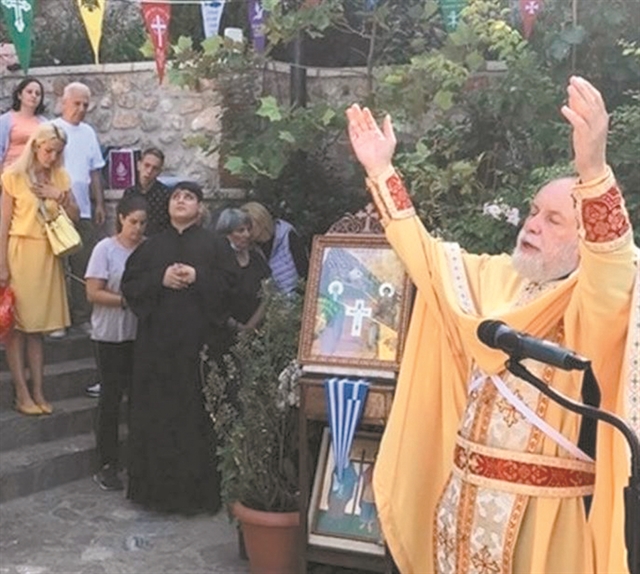Five years after a church probe that he had ordered condemned the “miracle-working” priest, Demetrios Loupasakis, who drew thousands of faithful with a crucifix that he claimed to contain part of the True Cross of Christ, to the church of the Saints Isidore on Mount Lycabettus in Athens, Archbishop Ieronymos has said he will remove the priest and his entourage from the chapel, giving them a five-day deadline and the option of moving to an ecclesiastical foundation in Vari, where their activities will be monitored.
The 63-year-old priest has said that he will obey the decision of the archbishop, who reportedly wanted to give him a “second chance”.
In an interview with the Sunday edition of Kathimerini, Ieronymos broke years of silence to explain his recent decision to remove the charlatan priest who claimed that his crucifix performed hundreds if not thousands of miracles, healing a host of even incurable diseases.
A number of personalities from the arts and politics reportedly were among the thousands of faithful who flocked to the chapel for divine intercession through the crucifix.
Metropolitan bishop of Argolida’s intervention helped lead to action
Metropolitan bishop Nektarios of Argolida in June unleashed an attack against Loupasakis. He spoke of fake miracles and cited one case in which the parents cut off their child’s medical treatment with the belief that the priest with the crucifix would cure it, but the child died.
“They called me from Thessaloniki and told me that we had a sick child and we ceased its hospital therapy. We travelled to the Church of the Saints Theodore but the child’s condition worsened and it died,” Nektarios told Alpha television last June.
His accusations and the leak of the “buried” report led the archbishop and the Holy Synod to take decisive action.
Archbishop’s revealed his intentions in address to Metropolitan bishops
The archbishop in a recent address to the hierarchy of the Holy Synod unleashed criticism of the activities at the Mount Lycabettus chapel, which for years has also been a popular place for weddings.
The speech came after the leak of an August, 2017, final report of a Church probe, ordered by Archbishop Ieronymos, charged Loupasakis with very weighty violations of church canons and concluded that the priest’s case must be brought to trial, but for reasons unknown that was never done.
The ecclesiastical court probe lasted three years, from 2014 to 2017, and was conducted by the current Metropolitan Ieronymos of Larisa, who then was secretary of the church court. Dozens of depositions were taken regarding the priest and his “miracle-working” crucifix.
‘Buried’ Church report against ‘miracle-working’ priest, crucifix leaked
In its conclusions, the report recommended that Loupasakis undergo psychiatric testing to determine if he is mentally fit to carry out his mission and that he be referred to the Church court system and tried if deemed fit on a variety of charges.
They included charlatanism, skewing the traditions of the Holy Canons (the report noted that the archbishop did not wish the priest to be charged with heresy), disobedience and contempt of the local bishop (Archbishop Ieronymos), offending the Holy Mystery of Marriage and neglect of the priest’s own family, being involved in organising ordinations beyond his ecclesiastical jurisdiction without those being ordained knowing that, disobedience, usurpation of the role of spiritual father, conspiracy and factionalism that overturns the ecclesiastical order in the archdiocesan chapel of the Saints Isidore (which is under the jurisdiction of the Archdiocese of Athens) and the establishment of a monastic brotherhood without the authorisation of the archbishop.
Embezzlement charge dropped
The report recommended that the charge of consistent embezzlement of church revenues be changed to violating and overstepping his responsibility and usurpation of authority and breach of duty, and extremely strong scandalising of the consciences of the faithful.
Such Orthodox shrines that are linked to miracle-working icons or relics rake in huge amounts in donations from the faithful, all the more so at a shrine where the miracles supposedly include the healing of incurable ailments, from blindness and physical disability to multiple sclerosis.
Many have maintained that the case was “buried” for the last five years, both at the church and judicial levels.
Ieronymos explains his stance
The archbishop in his interview with Kathimerini attempted to explain his reluctance to take action against Loupasakis over the last five year since the report was issued.
“The responsibility fell upon me. What am I, a military commander, a police chief, or a father? Let us say you have a child that misbehaves, won’t you try to advise it? I decided to bear the burden, but also to act as a father. He [Loupasakis] is not alone. There are 16 youths [monks] from 25 to 30 years old, a community without a legal foundation. I called them in and spoke to them and asked them if they wanted to become monks. I told them you cannot do that here as there is no monastery. Should I not have helped them?” Ieronymos said in his interview.
Ieronymos’ ultimatum: five days to evacuate Lycabettus chapel, quarters
The archbishop acknowledged that the report drafted by the current Metropolitan bishop of Larisa in 2017 at the conclusion of the investigation of Loupasakis was very harsh but not far from the truth.
Ieronymos said that he gave Loupasakis and the monks following him an ultimatum, giving them five days to leave the Moungt Lycabettus chapel and relocate to a facility in the southern Athens suburb of Vari, which will serve as a monastery with a legal ecclesiastical standing.
He said that this way the Church will be able to monitor the activities of Loupasakis and his entourage, who until now was accountable to no one and was receiving donations with absolutely no transparency. He was accountable to no one.
Ieronymos forbids use of Loupasakis’ crucifix
Ieronymos reportedly opted for the aforementioned formula, of relocating the priest and his entourage instead of opening an ecclesiastical court case and a probe of the shrine’s finances in order to avoid a divisive uproar and tumult in the ranks of the Church.
He said that if the group accepted the offer, which it has, their activity in Vari will be monitored by the Archdiocese, and that the crucifix must be placed in a showcase where one can venerate it, but the priest will not be able to instrumentalise it [use it for supposed healing of diseases].
It is unclear whether the Greek judiciary and prosecutors will pursue charges lodged against the priest over the years.
Ieronymos: priest’s modus operandi same as para-ecclesiastical groups’ in the past
Ieronymos was asked by Kathimerini: “Are there behaviours within the Church that alienate the faithful, and what is going on at Saints Isidore Church and how will it be handled?”
“Those who have not taken an interest in ecclesiastical affairs are making a mistake. They think this is the first time something like this is happening. It has happened many times in the past with Christian organisations, which began in this manner, but they were more polite. Here we are dealing with great arrogance. In the 1950’s and 1960’s all of Greece was governed [religiously] by [para-ecclesiastical] Christian organisations – [the semi-monastic Brotherhood of Theologians] Zoe, [the even more conservative splinter group] Sotiras, [ultra-conservative zealot Metropolitan bishop Avgoustinos] Kantiotis, and so forth.”
Ieronymos: ‘I have not been pressured by powerful divs’
“That is how all of them began and that is how this is starting now. He [Loupasakis] has a certain arrogance. We do not know on what springboard [backing] that is based and that has concerned us and continues to. Many people who were hurting went there and come here disappointed. It is a phenomenon that came and will leave,” Ieronymos replied.
“I have not been pressured by powerful divs regarding the priest at the Church of the Saints Isidore. That is incorrect,” the archbishop maintained.




